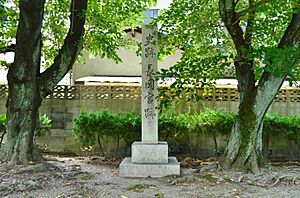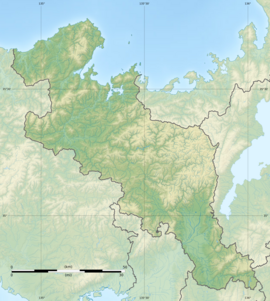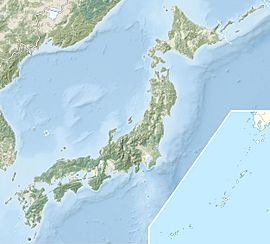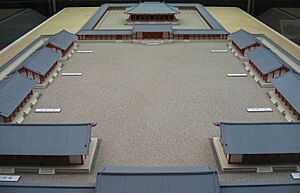Nagaoka-kyō facts for kids
|
長岡京
|
|

Nagaoka Palace ruin monument in Mukō, Kyoto Prefecture
|
|
| Location | Mukō, Kyoto, Japan |
|---|---|
| Region | Kinai region |
| Coordinates | 34°56′36.6″N 135°42′11.4″E / 34.943500°N 135.703167°E |
| History | |
| Periods | Nara - Heian period |
| Site notes | |
| Public access | Yes (no facilities) |
Nagaoka-kyō (長岡京) was the capital of Japan for a short time. It served as the main city from 784 to 794. This ancient capital was located in what is now Mukō and Nagaokakyō, Kyoto cities. It also included parts of Ōyamazaki town and Nishikyō-ku ward in Kyoto. The old palace ruins were found in Mukō city. This important historical site has been protected since 1964.
Contents
Why a New Capital?
Emperor Kanmu ordered the building of Nagaoka-kyō. He wanted a new capital because the old one, Heijō-kyō, had some problems. Heijō-kyō was about 40 kilometers south. The emperor hoped Nagaoka-kyō would be a better place for the government.
Better Location for Trade
Nagaoka-kyō was built where three big rivers met. These were the Katsura River and the Uji River, which formed the Yodo River. This made it easy to move goods by boat. A port called Yamazakitsu was set up. Ships could bring supplies from all over Japan. Then, smaller boats would take them right to Nagaoka-kyō. The old capital, Heijō-kyō, could only be reached by land. This new water route was much more efficient.
A Cleaner City Design
Archaeologists have found that most houses in Nagaoka-kyō had their own wells. The city also had a system for sewage. This was a big improvement from Heijō-kyō. Water from natural springs flowed through the city. It helped keep the streets clean. The city was built on a gentle slope. This allowed dirt and waste to be washed away into the river.
Symbol of Imperial Power
The imperial palace in Nagaoka-kyō was built on a small plateau. It was about 15 meters higher than the rest of the city. This design showed the emperor's authority clearly. In contrast, the old capital, Heijō-kyō, was completely flat. This new layout made the emperor's power more visible.
Political Reasons for the Move
Emperor Kanmu also wanted to solve political issues. He worked closely with Fujiwara no Tanetsugu on the new capital's location. Nagaoka was Tanetsugu's family home. This meant the powerful Fujiwara clan would have strong support there. The emperor also wanted to be further from the Buddhist temples in Heijō-kyō. These temples had become very involved in politics. He also aimed to improve ties with rich immigrant families. These families lived in southern Yamashiro Province. The emperor's mother was from one of these families.
Building and Challenges
The new palace was built very quickly. New Year's ceremonies were held there in 785. This was only six months after construction began. People in Heijō-kyō were not happy about the capital moving. Usually, old palace buildings were taken apart and moved. But for Nagaoka-kyō, the Heijō-kyō palace was left untouched. Instead, buildings from the Naniwa-kyō palace were moved.
Troubles and a Vengeful Spirit
Soon after the move, problems began. In September 785, Fujiwara no Tanetsugu was attacked and died. Some officials were thought to be involved. Emperor Kanmu's younger brother, Prince Sawara, was also put in prison. He was against moving the capital. The prince died while being sent away. People believed he died with a strong feeling of anger.
After Prince Sawara's death, many bad things happened. There was a drought, which led to famine and sickness in 792. The Empress and other close family members of the emperor died. The main hall of Ise Grand Shrine burned down. The Crown Prince also became ill.
The next year, a spiritual advisor called an onmyōji said these disasters were caused by Prince Sawara's onryō. This means a vengeful spirit. Even after trying to calm the spirit, heavy rains and floods damaged Nagaoka-kyō. An important aristocrat named Wake no Kiyomaro suggested moving the capital again. A new site was chosen in 793. The capital officially moved to Heian-kyō in 794.
What Happened Next?
After the capital moved, the Nagaoka-kyō area became the land of Sugawara no Michizane. Later, the Nagaoka Tenman-gu Shinto shrine was built there. This happened after Michizane was sent away from the capital in 901. The name "Nagaoka" stayed as a place name. But the exact spot of the old palace was lost for many centuries. It was finally found again in 1954. Since then, many archaeological digs have taken place.
Images for kids
See also
 In Spanish: Nagaoka-kyō para niños
In Spanish: Nagaoka-kyō para niños











